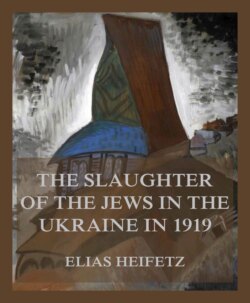Читать книгу The Slaughter of the Jews in the Ukraine in 1919 - Elias Heifetz - Страница 4
PREFACE
ОглавлениеThe basis of this book is material gathered by delegates of the All-Ukrainian Relief Committee for the Victims of Pogroms, under the auspices of the Red Cross, of which committee I was the chairman.
Our aim was not only to supply money, food and clothing to the victims, render medical aid to the wounded and mutilated, and take care of the orphaned children; it was also to investigate to determine the true character of the events and ascertain the circumstances in which they occurred. Besides administering relief, our representatives, in accordance with a plan worked out by the Central Information Department of the committee, made careful investigations, questioning witnesses of all descriptions, the sufferers themselves, onlookers, and men in official or public positions. In large centres like Kiev and Yekaterinoslav, to which refugees from numerous pogrom-stricken localities streamed, special bureaus were established for the purpose of taking down the testimony of the refugees. Sometimes, when the pogrom was large and complicated in its character, our committee delegates called conferences of all public and party organizations of the place, in order to determine the social and political causes of the pogrom and the motives animating the participants, as well as to gather all possible details. The conferees were able, through personal observation and material at their disposal, to clear up obscurities, throw light on all aspects of the situation, and make corrections and addenda to reports presented at the meetings. Examples of documents resulting from such conferences are the protocols with their appendices given in the Appendix to this book on the pogroms in Uman (pp. 316-336) and Dubovo (pp. 341-347). The material gathered at each place testimony of witnesses , documents, photographs was sent to the Central Information Department in Kiev, where it was classified and sifted by experts. What seemed of dubious veracity or did not coincide with other evidence was rejected. Nothing but verified matter was included in our summary.
In some cases of pogroms on a large scale special investigators, persons with a thorough legal training, were sent to the scene of the events, who supplemented evidence already to hand by securing documents and examining new witnesses. Material thus gathered was embodied in volumes sometimes numbering several hundred pages, to which the investigator later, in his summarized report, would refer, citing the page and number of the volume in the case, as, for instance, the reports of the well-known lawyer, Mr. A. I. Hillerson, on the pogroms in Ovruch (see Appendix, pp. 185 ff.) and in Proskurov (see Appendix, pp. 202 ff.), who substantiated his statements by exact references (as on pp. 208, 209, 210 and elsewhere).
Owing to the various war fronts in the Ukraine and the internal state of civil war, we were prevented from gathering material for all the pogroms. Nevertheless, the facts brought to light through the self-sacrificing efforts of our representatives are quite sufficient for a thoroughly grounded analysis, social and political, of the Jewish tragedy in the Ukraine in 1919. And as our committee was a Red Cross organization with non-political aims, the work of investigation was carried on in an utterly impartial spirit.
Most of the material at my disposal appears in the Appendix, some of it in the text. The book represents my personal conclusions drawn from the material and from my observations of the stormy events in the Ukraine.
It is more than a year now since the ghastly events described in this book took place. But the year 1919 did not see the end of them. The bloody tide overflowed the boundaries of the Ukraine, and horrors were enacted elsewhere that not only equaled but even surpassed the Ukrainian atrocities. And in the Ukraine itself reaction kept up its gory carnival. The events of 1920 only corroborate the findings in the present book, namely, that reaction uses the massacre of the Jews as a method for political warfare.
In conclusion I wish to express my gratitude to all my fellow-workers on the Relief Committee. My indebtedness to them is twofold for the moral satisfaction of work done together in aid of the wretched victims of the pogroms and for the stupendous, tireless work of gathering the evidence that has made possible the writing of this summary. I must make special mention of those who stood closest to me in the work: Dr. P. I. Rosenthal (Anman), Dr. F. E. Lander, Mr. L. V. Fraenkel, Mr. S. Y. Heifetz, Dr. L. N. Heller, Mr. A. I. Hillerson, and Mr. Isaac Gutermann.
ELIAS HEIFETZ.
NEW YORK, December 20, 1920.
